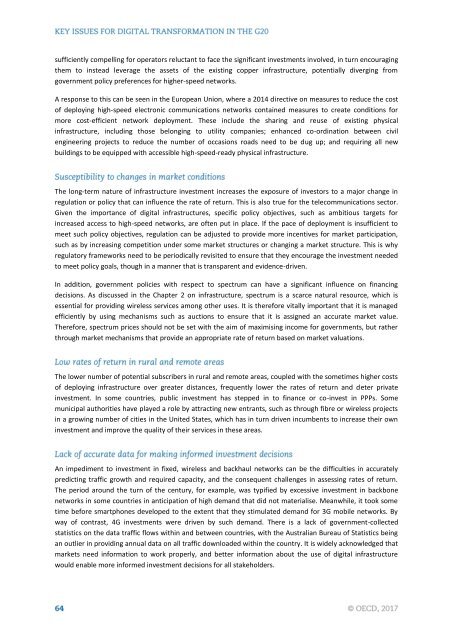KEY ISSUES FOR DIGITAL TRANSFORMATION IN THE G20
2jz0oUm
2jz0oUm
You also want an ePaper? Increase the reach of your titles
YUMPU automatically turns print PDFs into web optimized ePapers that Google loves.
sufficiently compelling for operators reluctant to face the significant investments involved, in turn encouraging<br />
them to instead leverage the assets of the existing copper infrastructure, potentially diverging from<br />
government policy preferences for higher-speed networks.<br />
A response to this can be seen in the European Union, where a 2014 directive on measures to reduce the cost<br />
of deploying high-speed electronic communications networks contained measures to create conditions for<br />
more cost-efficient network deployment. These include the sharing and reuse of existing physical<br />
infrastructure, including those belonging to utility companies; enhanced co-ordination between civil<br />
engineering projects to reduce the number of occasions roads need to be dug up; and requiring all new<br />
buildings to be equipped with accessible high-speed-ready physical infrastructure.<br />
The long-term nature of infrastructure investment increases the exposure of investors to a major change in<br />
regulation or policy that can influence the rate of return. This is also true for the telecommunications sector.<br />
Given the importance of digital infrastructures, specific policy objectives, such as ambitious targets for<br />
increased access to high-speed networks, are often put in place. If the pace of deployment is insufficient to<br />
meet such policy objectives, regulation can be adjusted to provide more incentives for market participation,<br />
such as by increasing competition under some market structures or changing a market structure. This is why<br />
regulatory frameworks need to be periodically revisited to ensure that they encourage the investment needed<br />
to meet policy goals, though in a manner that is transparent and evidence-driven.<br />
In addition, government policies with respect to spectrum can have a significant influence on financing<br />
decisions. As discussed in the Chapter 2 on infrastructure, spectrum is a scarce natural resource, which is<br />
essential for providing wireless services among other uses. It is therefore vitally important that it is managed<br />
efficiently by using mechanisms such as auctions to ensure that it is assigned an accurate market value.<br />
Therefore, spectrum prices should not be set with the aim of maximising income for governments, but rather<br />
through market mechanisms that provide an appropriate rate of return based on market valuations.<br />
The lower number of potential subscribers in rural and remote areas, coupled with the sometimes higher costs<br />
of deploying infrastructure over greater distances, frequently lower the rates of return and deter private<br />
investment. In some countries, public investment has stepped in to finance or co-invest in PPPs. Some<br />
municipal authorities have played a role by attracting new entrants, such as through fibre or wireless projects<br />
in a growing number of cities in the United States, which has in turn driven incumbents to increase their own<br />
investment and improve the quality of their services in these areas.<br />
An impediment to investment in fixed, wireless and backhaul networks can be the difficulties in accurately<br />
predicting traffic growth and required capacity, and the consequent challenges in assessing rates of return.<br />
The period around the turn of the century, for example, was typified by excessive investment in backbone<br />
networks in some countries in anticipation of high demand that did not materialise. Meanwhile, it took some<br />
time before smartphones developed to the extent that they stimulated demand for 3G mobile networks. By<br />
way of contrast, 4G investments were driven by such demand. There is a lack of government-collected<br />
statistics on the data traffic flows within and between countries, with the Australian Bureau of Statistics being<br />
an outlier in providing annual data on all traffic downloaded within the country. It is widely acknowledged that<br />
markets need information to work properly, and better information about the use of digital infrastructure<br />
would enable more informed investment decisions for all stakeholders.


